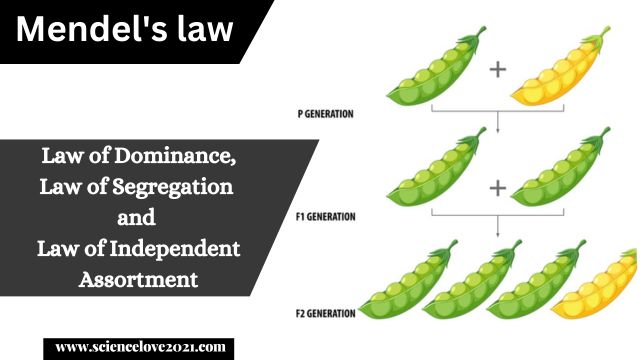Mendel's law
Mendel had presented Mendelism. He first worked on green peas (Pisum sativum) from which he discovered 7 pairs of contrasting characters. He is known as the father of Genetics.
Mendel had propounded three laws of heredity which are as follows-
- Law of Dominance
- Law of Segregation
- Law of Independent Assortment
Law of Dominance
According to this rule, when Mendel crossed a pair of opposite characters, only dominant characters appeared in the first generation. This is called Law of Dominance.
For example, if dominant red (RR) is crossed with recessive white (rr), then dominant (Rr) traits will appear in the first generation.
Law of Segregation
According to this rule, when Mendel crossed a pair of opposite genetic characters, he saw the dominant character in the first generation But both types of characters (Rr) were present in the first generation which separated after self cross without contaminating each other. This is called the law of segregation.
For example, when dominant red (RR) is crossed with recessive white (rr), dominant (Rr) traits will appear in the first generation. When the dominant Rr was self-crossed, it separated in the next generation without contaminating each other.
Read also: Genetic code
Law of Independent Assortment
This law of Mendel is based on Dihybrid cross. According to this rule, when Mendel crossed between two pairs of opposite genetic characters, dominant characters appeared in the first generation. These characteristics were separated without contaminating each other. They became completely independent from each other when they were self-crossed in the next generation. This is called the law of independent assortment.
➤ He already knew by the law of dominance that round shape of seeds is dominant to wrinkled shape and yellow color of cotyledons to green. Therefore, when they were crossed with the P plant, all the plants in the F1 generation (dihybrids) produced round seeds with yellow cotyledons by self-pollination.
He collected these seeds and sowed them at different places to grow F2 generation plants. They also allowed self-pollination in these plants and found that 315 plants produced round seeds with yellow cotyledons, 108 had round seeds with green cotyledons, 101 had wrinkled seeds with yellow cotyledons and 32 had wrinkled seeds with green cotyledons. It is clear that the number of these four types of plants was in the ratio of about 9 : 3 : 3 : 1 respectively.
Read also: Chromosome
FAQs
1. What were Mendel's 3 important discoveries?
Gregor Mendel's three important discoveries were:
- He said that traits are inherited in different units. Mendel called these units “factors,” but today we know them as genes.
- Genes come in pairs, receiving one gene from each parent.
- The alleles (different forms of a gene) separate during gamete formation, and each gamete receives one allele for each trait.
2. What three statements summarize Mendel's three laws of genetics?
The three laws of genetics, also known as Mendel's laws:
- Law of dominance: When two different alleles are present in an individual, one allele is dominant and the other allele is recessive. Therefore, symptoms of the dominant allele are visible in the first generation.
- Law of Segregation: During gamete formation, two alleles for each trait segregate from each other, and each gamete receives only one allele for each trait.
- Law of independent assortment: Alleles for different traits come together independently of each other. This means that one trait does not affect the inheritance of another trait.
3. Is the Law of dominance always true?
The Law of Dominance is not always true. There are some cases where both alleles are expressed, even if one is dominant. This is called incomplete dominance. There are also cases where the two alleles interact to produce a new phenotype, which is different from either parent. This is called codominance.
4. What are the three laws of Mendel?
The three laws of Mendel are: Law of Dominance, Law of Segregation, Law of independent assortment.
5. What is Mendel's 1st and 2nd law?
Mendel's 1st law is the Law of Dominance. Mendel's 2nd law is the Law of Segregation.

.webp)
.webp)
.webp)


No comments:
Post a Comment